必修三Unit1Reading
- 格式:ppt
- 大小:8.78 MB
- 文档页数:42
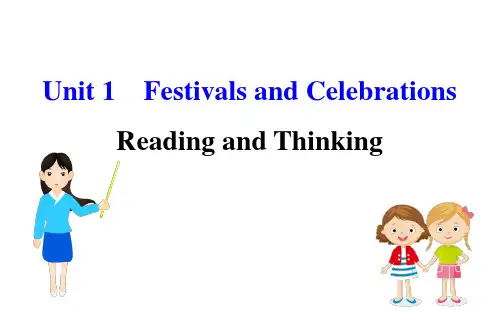
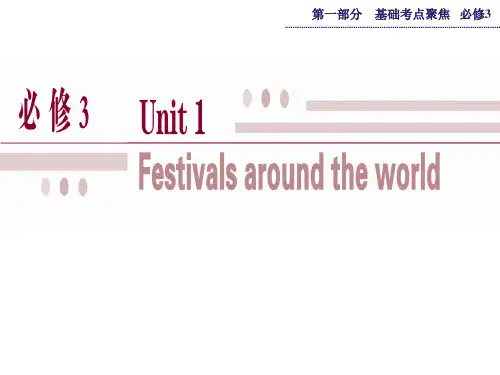
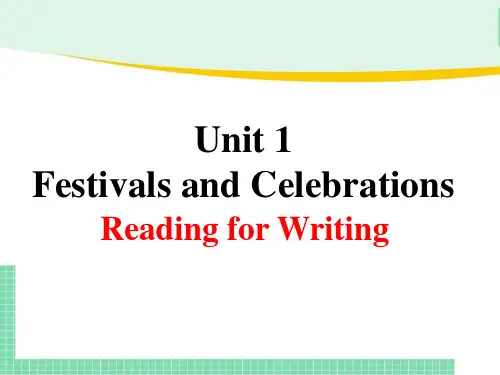
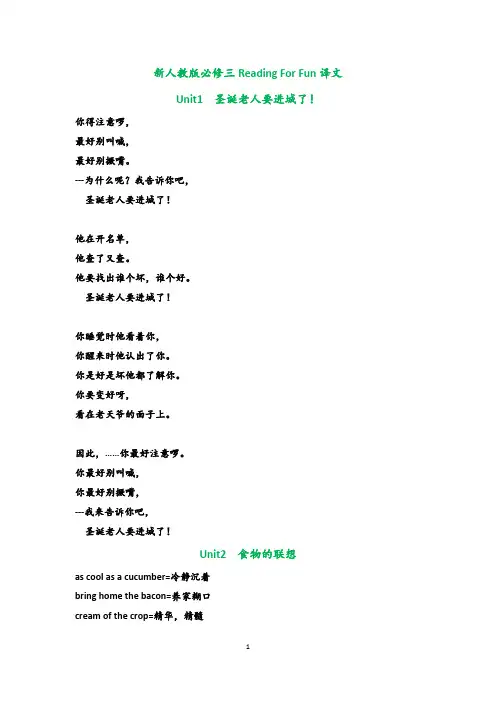
新人教版必修三Reading For Fun译文Unit1 圣诞老人要进城了!你得注意啰,最好别叫喊,最好别撅嘴。
---为什么呢?我告诉你吧,圣诞老人要进城了!他在开名单,他查了又查。
他要找出谁个坏,谁个好。
圣诞老人要进城了!你睡觉时他看着你,你醒来时他认出了你。
你是好是坏他都了解你。
你要变好呀,看在老天爷的面子上。
因此,……你最好注意啰。
你最好别叫喊,你最好别撅嘴,---我来告诉你吧,圣诞老人要进城了!Unit2 食物的联想as cool as a cucumber=冷静沉着bring home the bacon=养家糊口cream of the crop=精华,精髓full of beans=精力充沛的mutton dressed as lamb=打扮成年轻人的老年人raw deal=不公平的待遇like peas in a pod =都一个样Unit3 马克·吐温的妙语●银行家是这样一个伙计,出太阳的时候他把雨伞借给你;一旦下雨,他就把伞要回去。
●我没有参加那次葬礼,但是我寄出过一封信,好言相告说,那次葬礼我是赞同的。
●古典作品是人们都希望自己已经读过,但实际上是无人想读的书。
●我年轻时,无论什么事---发生过的还是未发生过的,都记得清。
●谎言可传千里,真理寸步难行。
Unit4 太阳在运转罗伯特·路易斯·斯蒂文森夜里我抱枕眠,太阳不在我床边。
它在绕着地球转,一天又一天。
阳光普照我家园,我们嬉戏在花园。
此时此刻在印度,妈妈吻着宝宝到床沿。
大洋彼岸天刚晓,我们喝完午茶起身了。
此时此刻在西方,孩子们起床梳妆打扮了。
Unit5 我心在飞翔奇夫·丹·乔治森林的美丽,空气的轻柔,花草的芳香,它们都在跟我诉说。
高山的巅峰,天空的雷鸣,海里的旋律,它们都在跟我诉说。
烈火的威力,鲑鱼的鲜美,太阳的轨迹,永不消逝的活力,它们都在跟我诉说。
我心在飞翔。
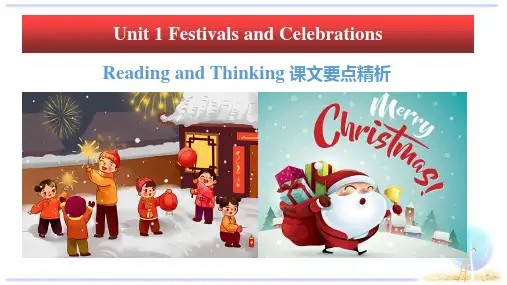
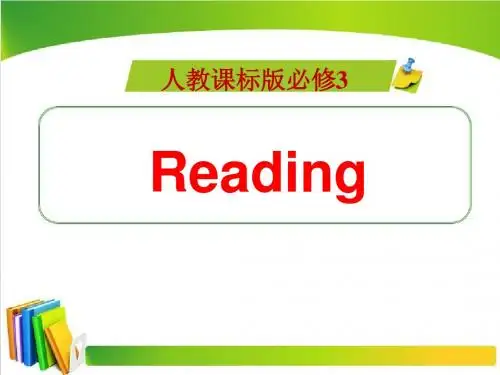
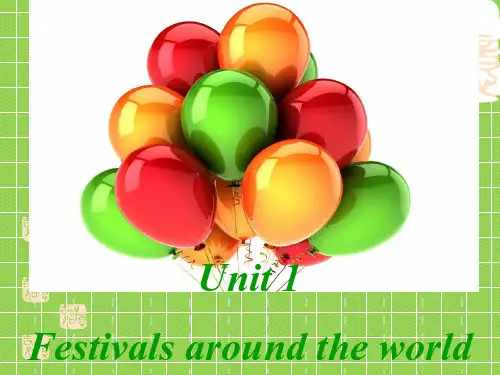
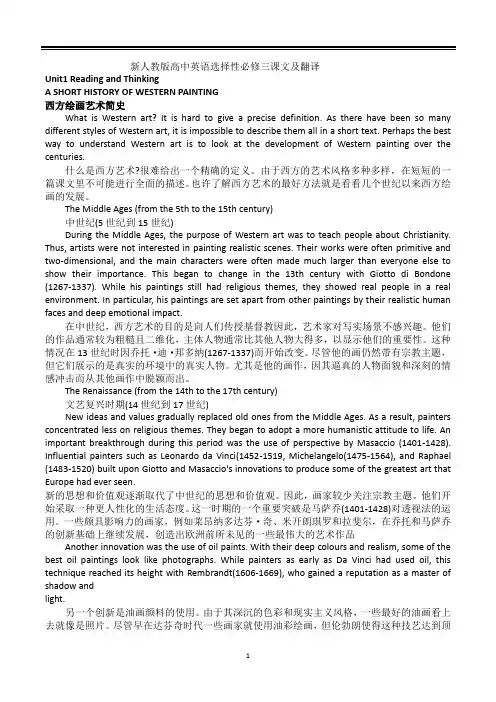
新人教版高中英语选择性必修三课文及翻译Unit1 Reading and ThinkingA SHORT HISTORY OF WESTERN PAINTING西方绘画艺术简史What is Western art? It is hard to give a precise definition. As there have been so many different styles of Western art, it is impossible to describe them all in a short text. Perhaps the best way to understand Western art is to look at the development of Western painting over the centuries.什么是西方艺术?很难给出一个精确的定义。
由于西方的艺术风格多种多样,在短短的一篇课文里不可能进行全面的描述。
也许了解西方艺术的最好方法就是看看几个世纪以来西方绘画的发展。
The Middle Ages (from the 5th to the 15th century)中世纪(5世纪到15世纪)During the Middle Ages, the purpose of Western art was to teach people about Christianity. Thus, artists were not interested in painting realistic scenes. Their works were often primitive and two-dimensional, and the main characters were often made much larger than everyone else to show their importance. This began to change in the 13th century with Giotto di Bondone (1267-1337). While his paintings still had religious themes, they showed real people in a real environment. In particular, his paintings are set apart from other paintings by their realistic human faces and deep emotional impact.在中世纪,西方艺术的目的是向人们传授基督教因此,艺术家对写实场景不感兴趣。
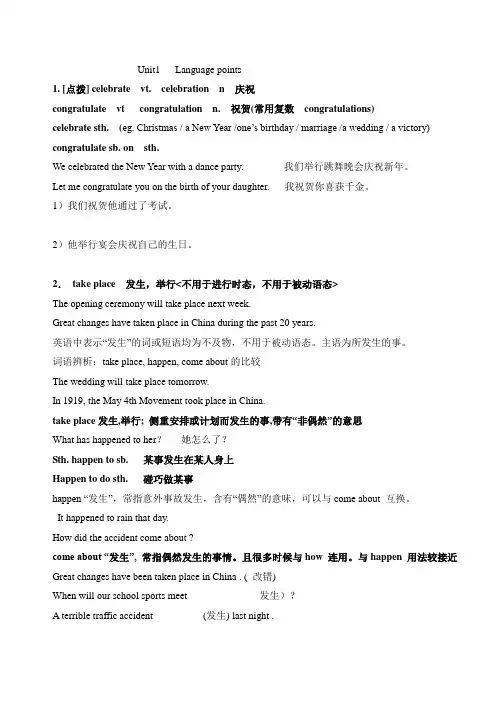
Unit1 Language points1. [点拨] celebrate vt. celebration n 庆祝congratulate vt congratulation n. 祝贺(常用复数congratulations)celebrate sth. (eg. Christmas / a New Year /one’s birthday / marriage /a wedding / a victory) congratulate sb. on sth.We celebrated the New Year with a dance party. 我们举行跳舞晚会庆祝新年。
Let me congratulate you on the birth of your daughter. 我祝贺你喜获千金。
1)我们祝贺他通过了考试。
______________________________________________________________2)他举行宴会庆祝自己的生日。
______________________________________________________________2.take place 发生,举行<不用于进行时态,不用于被动语态>The opening ceremony will take place next week.Great changes have taken place in China during the past 20 years.英语中表示“发生”的词或短语均为不及物,不用于被动语态。
主语为所发生的事。
词语辨析:take place, happen, come about的比较The wedding will take place tomorrow.In 1919, the May 4th Movement took place in China.take place发生,举行; 侧重安排或计划而发生的事,带有“非偶然”的意思What has happened to her?她怎么了?Sth. happen to sb. 某事发生在某人身上Happen to do sth. 碰巧做某事happen “发生”,常指意外事故发生,含有“偶然”的意味,可以与come about 互换。
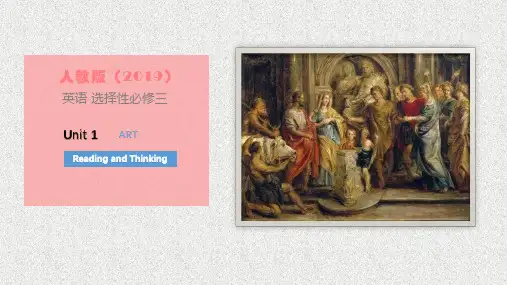
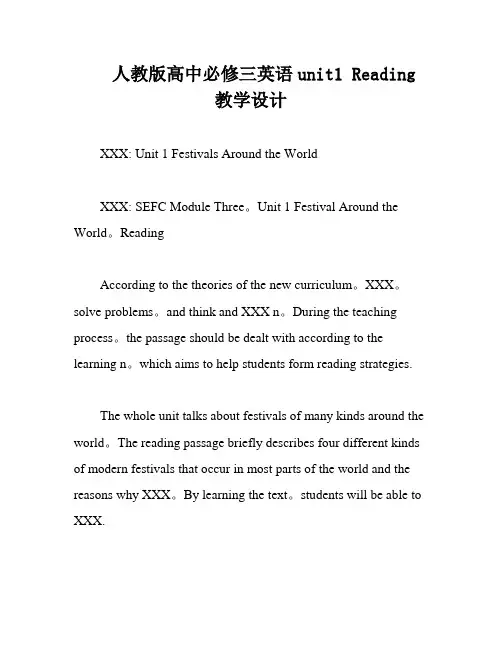
人教版高中必修三英语unit1 Reading教学设计XXX: Unit 1 Festivals Around the WorldXXX: SEFC Module Three。
Unit 1 Festival Around the World。
ReadingAccording to the theories of the new curriculum。
XXX。
solve problems。
and think and XXX n。
During the teaching process。
the passage should be dealt with according to the learning n。
which aims to help students form reading strategies.The whole unit talks about festivals of many kinds around the world。
The reading passage briefly describes four different kinds of modern festivals that occur in most parts of the world and the reasons why XXX。
By learning the text。
students will be able to XXX.The topic of this unit is related to the students' life experiences。
XXX。
due to varying English levels。
I will design reading activities of different levels to meet their XXX class.The knowledge aims of this unit are to help students master important words and phrases。
Unit 1 Nature in the balanceWelcome to the unit & Reading (I)◆内容分析:本板块围绕单元话题以“保护我们的唯一家园——地球”创设情境,展开一系列听、看、说、写等任务活动。
任务活动设计围绕一首英文歌曲展开,旨在让学生明白:人类应该对大自然心怀感恩,对所造成的环境危害心存愧疚,并果断采取措施来保护我们的家园。
Welcome to the unit板块通过歌曲的形式,着重培养学生听和读的语言技能——婉转悠扬的曲调、简单易懂的歌词,可以让学生在学唱的过程中激发探究本单元的兴趣,为单元学习做好热身。
阅读板块是纪录片脚本,内容围绕亚马孙雨林展开,包括亚马孙雨林的基本信息、动植物资源、生物多样性、对地球的重要作用,以及所面临的危险等。
◆教学目标:By the end of this section, students will be able to:1.sing the English song;2.know the harm we have done to the Earth;3.understand the significance of environmental protection.◆教学重难点:1.Understand the concept of “balance of nature” from two ways;2.Learn to sing the song “T he Earth is our only home.” after discussing questions concerning environmental protection;3. Learn to use the basic data about the Amazon Rainforest to call on people to protect the “Lung of the Earth”.◆教学过程:Step 1 Lead-inQ1: What key words can you think of when we talk about balance of nature? Ecosystem, wildlife, rain forest, human being, pollution, environmental protection, species, survive, greenhouse effect, global warming, extinction, low carbon life and so on.Q2: Look at the slides, what are these animals? What is the relationship between them?Picture one: Jaguar and sheepPicture two: Hawk and birdThey are predator and prey, they form the food chain in our nature. They are part of the ecosystem in our earth.Q3: What does this picture tell us?The number of predator and prey in nature is related.Q4: What does the concept “balance of nature” convey?The expression is often used one of two ways. Sometimes the balance is depicted asfragile, delicate, and easily disturbed. Other times it’s the opposite—that the balance of nature is so powerful that it can correct any imbalances on its own.Quote sharing:Q5: How do you understand Engels’ words about nature?Let us not, however, flatter ourselves overmuch an account of our human victories over nature. For each such victory nature takes its revenge on us.— Fredrich EngelsWe must protect the environment, or human being could not survive.【设计意图:快速引入话题,拓展相关词汇。
选择性必修三unit1 reading课文翻译加拿大——多元化的国度加拿大如同一朵盛开的花儿,绽放出惊人的美丽与丰富,深受那些喜欢其多元化的人们的青睐。
这是一个幅员辽阔、景色宜人的国家,从大西洋绵延至太平洋。
这也是世界上民族最为多元化的国家之一,有其独特的文化。
组成加拿大的十个省份和三个地区在地理风貌上有很大的差异。
太平洋海岸向东耸立着巍峨的落基山脉,这里有高耸的山峰和被冰川与水流侵蚀而成的深谷。
古老的冰川缓缓移动,向陆地靠近。
种类繁多的野生动物在偏远的森林中漫步。
国家公园的建立使得很多这样美丽的地方成为供公众游玩和欣赏的保护区,如班夫国家公园和贾斯珀国家公园。
加拿大真正独特的一处景点是雄伟壮阔的尼亚加拉瀑布。
水流从瀑布边缘倾泻而下,景色壮观,水声轰鸣。
除了其地理环境的多元化,加拿大的许多农村地区和城市中心还体现了其居民的多元化。
加拿大最早期的一些移民被认为是土著民族的祖先,从现称作西伯利亚的地方经由大陆桥穿越白令海峡而来。
数千年前,他们在这片辽阔的土地上定居。
数百年前,第一批欧洲人也开始在加拿大东部的一些省份定居。
今天,加拿大反映了各种民族背景的广泛融合。
加拿大人口中大约有五分之一是在外国出生的。
例如,主要的族群包括英格兰人、苏格兰人和法国人,而少数族裔包括来自新加坡和太平洋岛屿的居民。
种族多元化相应地导致文化多元化。
如果你发现自己置身于其中一种亚文化中,那么(它的)语言、饮食、建筑、艺术和音乐会说明你邂逅的是何种文化。
例如,在温哥华这个活力四射的城市,加拿大华人的比例全国最高,你可以参加中国新年的庆祝活动,也可以到中山公园喝喝茶。
在蒙特利尔,世界最大的讲法语的城市之一,你可以品尝具有典型法式风味的美食,还可以观赏原汁原味的法式风格建筑。
最后,如果你想独辟蹊径的话,可以去新斯科舍省的布雷顿角岛玩玩。
在岛上你可以随着小提琴的曲调翩翩起舞,领略凯尔特移民的文化和传统。
当你接触到不同的文化时,你可能会产生穿越时空之感。
人教新课标英语必修三第一单元教案Unit 1Festivals around the WorldReading 教案Teaching goals1.To get the students to talk about festivals2.To learn about how festivals begin and how to celebrate festivals so as to enable them to learn more about different cultures while learning different language3.To develop the students’ reading skills : skimming, scanning, summarizing, and finding out details.4.To arouse the students’ interest in festivals, cultures, especially those in China,thus promote their culture awareness.Important pointsprehension of the reading part.2.Knowledge accumulation of festivals and cultures.eful words and expressions concerning festivals.Teaching aidsA computer, a projector, courseware, a tape-recorderTeaching proceduresStep 1 revisionRevise the festivals.Step 2 pre-readingWhat is your favourite holiday of the year? Why?Step 3 fast reading1.How many kinds of festivals are mentioned in the text? What are they?2. let’s get to know more about these festivals and fill in the form on P3.Ex1Step 4 careful readingParagraph 1:When did ancient people celebrate ?•at the end of winter•When good weather returned• a good harvest•animals caughtParagraph 2: Festivals of the dead1.What are festivals of the dead for?2. How do Japanese honour their ancestors?3. What do the people in Mexico do in memory of the dead?*Are there any similar festivals in China? What do do? What to eat?The Qingming FestivalParagraph 3: Festivals to honour peopleParagraph 4:Harvest Festivals1) Why are autumn festivals happy events?Because people are grateful and happy and a season of agricultural work is over.2) What do people do to celebrate it?In European countries, it is the custom to decorate churches and town halls with flowers and fruit; get together to have meals, win awards for their animals, flowers, fruit and vegetables; admire the moon Paragraph 5: Spring FestivalsParagraph 6: What are the purposes of festivals?Festivals: To have fun with each other / To let us enjoy life/ To be proud of our custom/ To forget our daily life for a little while/To honour the dead/To honour famous people/To celebrate harvest/To welcome a new year and look forward to the future/To ask people to pay attention to somethingStep 5 post readingDo T or F(1). The ancient people needn’t worry about their food. F(2). Halloween used to be a festival intended to honor the dead. T(3). Qu Y uan was a great poet whom people honor a lot in China. T(4). Mid-autumn Festival is held to celebrate the end of autumn. F(5). Easter celebrates the birth of Jesus. F(6). There is pink snow in spring in Japan. FStep 6 Group workFestivals are created. Now you’ve got the chance to create a new festival. Discuss in groups, make a plan:When the festival takes placeWhat the festival is forWhat people do at the festivalWhat people eat at the festivalSample: Peace DayIt takes place every year on January 2, the day after the New Year’s Day. At the beginning of a new year, we create such a festival in order to call for peace, to make the world a better place for everyone. People have to learn about foreign countries on that day. The TVs and newspapers will be all about foreign countries. And people are asked to eat foreign food on that day. And they are asked to talk about peace with their families, friends, and so on.HomeworkWrite an introduction of the festival your group have created.。